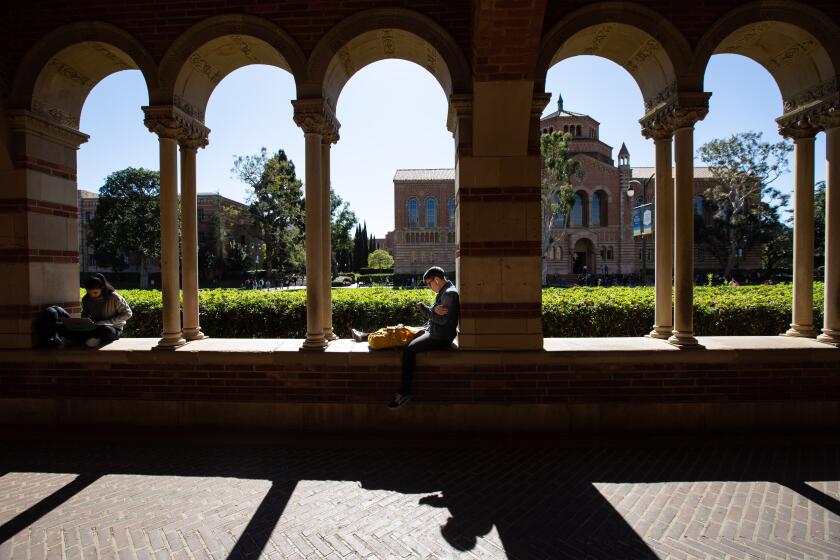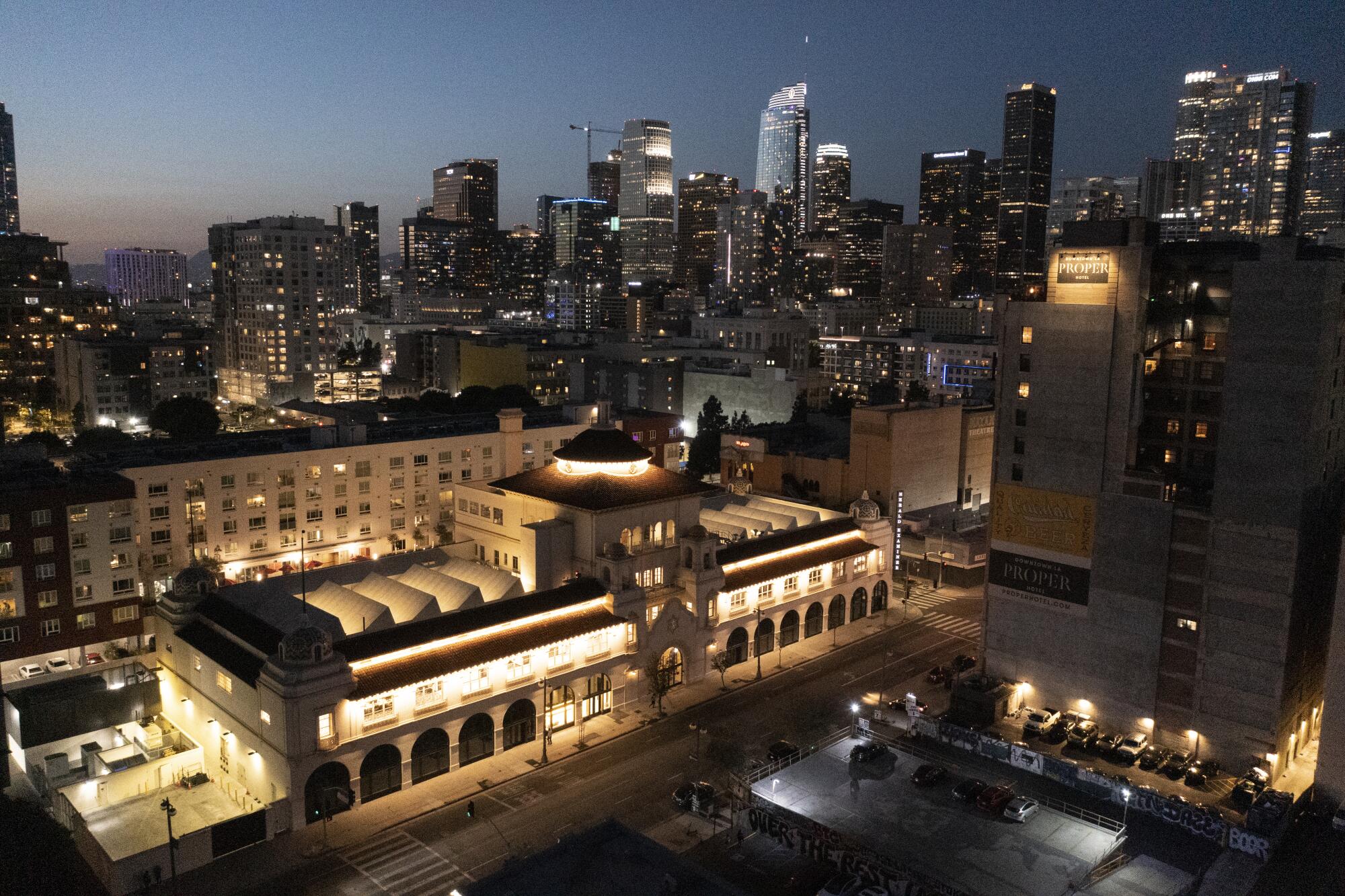
- Share via
Kiana Tovar was all set to attend Sacramento State. Kara Smith had firm plans: enroll at Santa Monica College, then apply to transfer to UCLA. Israel Cortave had been accepted to UC Merced and UC Riverside, which both offer the computer science and engineering majors he wants to explore.
All three students are now attending college in California, mixing state-of-the-art online classes with small in-person gatherings. They’ve been able to forge friendships, stay on track with “success coaches” and learn about career opportunities from industry professionals. But the name inscribed at the entrance of the university they decided to attend is not a California public institution.
It’s ASU — Arizona State University. And its newest campus is in Los Angeles.
After years of steadily targeting California, the No. 1 source of ASU’s out-of-state students, the university has planted its first flag in the heart of downtown with a high-profile, multimillion-dollar takeover of the landmark Herald Examiner Building. The upstart program is too tiny to measure now. But California public university leaders have taken note — and are watching whether ASU President Michael Crow’s alternative vision for higher education will be a trendsetting incubator launched in Los Angeles or a failed incursion into a neighboring state.
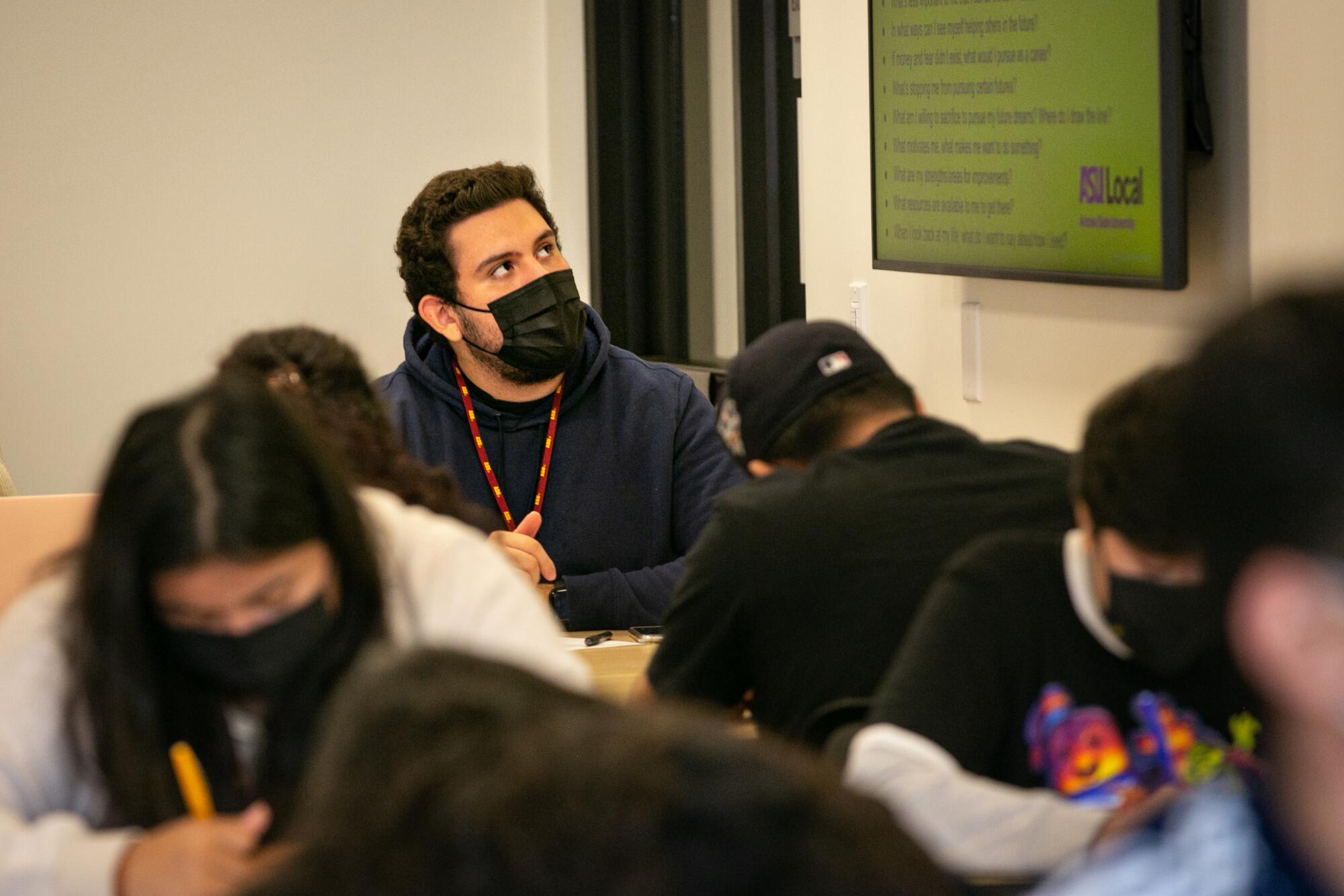
Crow sees California gold in the tens of thousands of students each year who are delivered rejection letters from the University of California’s and California State University’s most popular campuses — the annual heartbreak happening now. He gives both systems due respect, but says they’re stuck in old models of enrollment tied to availability of physical space and are failing to embrace technology to deliver education. And UC campuses have responded to surging demand mostly by becoming more selective, rather than more inclusive.
“They’ve bought into the logic of exclusion as a part of the measure of success,” Crow said of UC. “I don’t think a public university can do that. Our mission as a public university is to serve the public wherever they are and whatever they need.”
The University of California drew a record number of first-year applications for fall 2022, with gains in all underrepresented groups; transfer applications fell.
At UCLA — the most sought-after university in the nation — the average GPA of admitted first-year students last year rose to 4.5 and its admission rate dropped to 10%. In 1990, UCLA’s admission rate was 43%.
Crow lays out a different vision at ASU: broad access over selectivity, with an 88.2% admission rate for first-year students entering in fall 2021 and guaranteed acceptance to those with a minimum 3.0 GPA and completion of required college prep courses. ASU has vastly expanded its capacity to become one of the nation’s largest universities today — doubling its total enrollment in the last dozen years to 136,000 in fall 2021. The biggest growth has come in online enrollment, which now accounts for 43% of ASU students, with a growing share at several satellite sites outside the main Tempe campus in Phoenix, Mesa, Lake Havasu and elsewhere.

Californians made up 14% of ASU’s total enrollment of 129,000 in fall 2020 — two-thirds of them enrolled in online programs. They represented more than 10% of the 14,350 first-year, on-campus students in Arizona in fall 2021 — a record — and nearly one-third of those from out-of-state. Overall, that first-year class grew 12% over fall 2020, as ASU bucked national trends of declining enrollment at community colleges and some Cal State campuses.
UC officials say they don’t see ASU’s latest entry into the state as a competitive threat as much as an opportunity to learn. UC Berkeley Chancellor Carol Christ says she regards Crow as “one of the most interesting thinkers in higher education today” and last year invited him to address her top advisors to spark ideas about how to expand capacity, which she views as one of the university’s most pressing needs.
In a recent interview, Christ lamented a 2013 study by two UC researchers that found that California enrolled a lower proportion of its college students at four-year campuses than any other state.
ASU has used online instruction, technology tools and satellite campuses to increase enrollment, all measures Christ is considering for Berkeley. The UC system is vowing to add at least 20,000 more students by 2030.
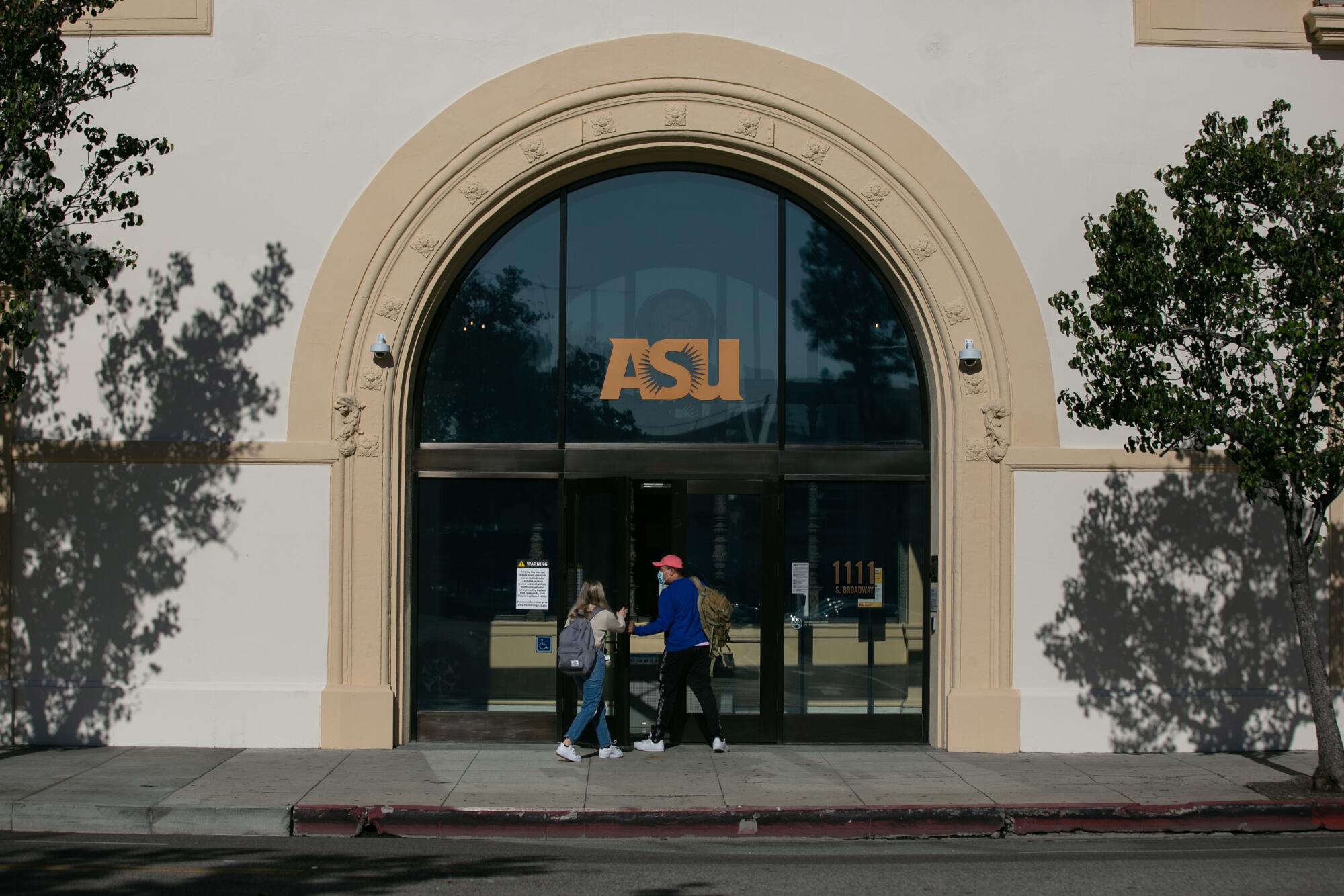
Christ describes Crow as “not being so much of a gatekeeper in selective admissions, but really trying to find ways of serving more students. The time has come for some very creative rethinking” at UC.
Cal State leaders, however, are acutely aware of Crow’s moves and wonder what they will mean for their own enrollment — which declined systemwide by 13,000 students last year — since the two universities draw applicants from similar academic profiles versus the more selective UC.
COVID-19 forced schools to shift to online learning. At CSU, it’s sticking around in what will be a new normal.
Cal State isn’t so concerned that ASU will siphon off students who want a full college experience — one leader called the ASU Los Angeles center a “stripped down version of a college education” without sports, clubs and other popular on-campus attractions. San Diego State, for instance, drew a record 77,000 first-year applicants for about 5,500 seats for fall 2022 — and those students want an on-campus, residential experience, said Stefan Hyman, associate vice president for enrollment management.
But as demand for online programs grow, particularly among older students, California public higher education leaders see ASU’s aggressive online moves as a challenge.

UC Regent Eloy Ortiz Oakley recently told fellow board members that UC needed to up its game in expanding online learning and access to nontraditional students because “we have our friends at Arizona State University chomping at the bit to take California students.” Oakley later told The Times that he doesn’t “begrudge” ASU for targeting Californians.
“But I also think it’s a lost opportunity for our own institutions because these are California students that are ready and willing to get into higher education and we’re just not providing them enough access,” said Oakley, chancellor of the 116-campus California Community Colleges system.
Chancellor Francisco Rodriguez of the nine-campus Los Angeles Community College District, however, praised ASU for forging a transfer admissions guarantee program for his students, whom he said too often get shut out of UC and Cal State.
Despite its growing prowess as an innovative research heavyweight, ASU struggles at times with a popular image as a hard-charging party school of mediocre quality — it was famously dissed by fashion designer Mossimo Giannulli as beneath his daughter when he was trying to bribe her into USC during the Varsity Blues college admission scandal.
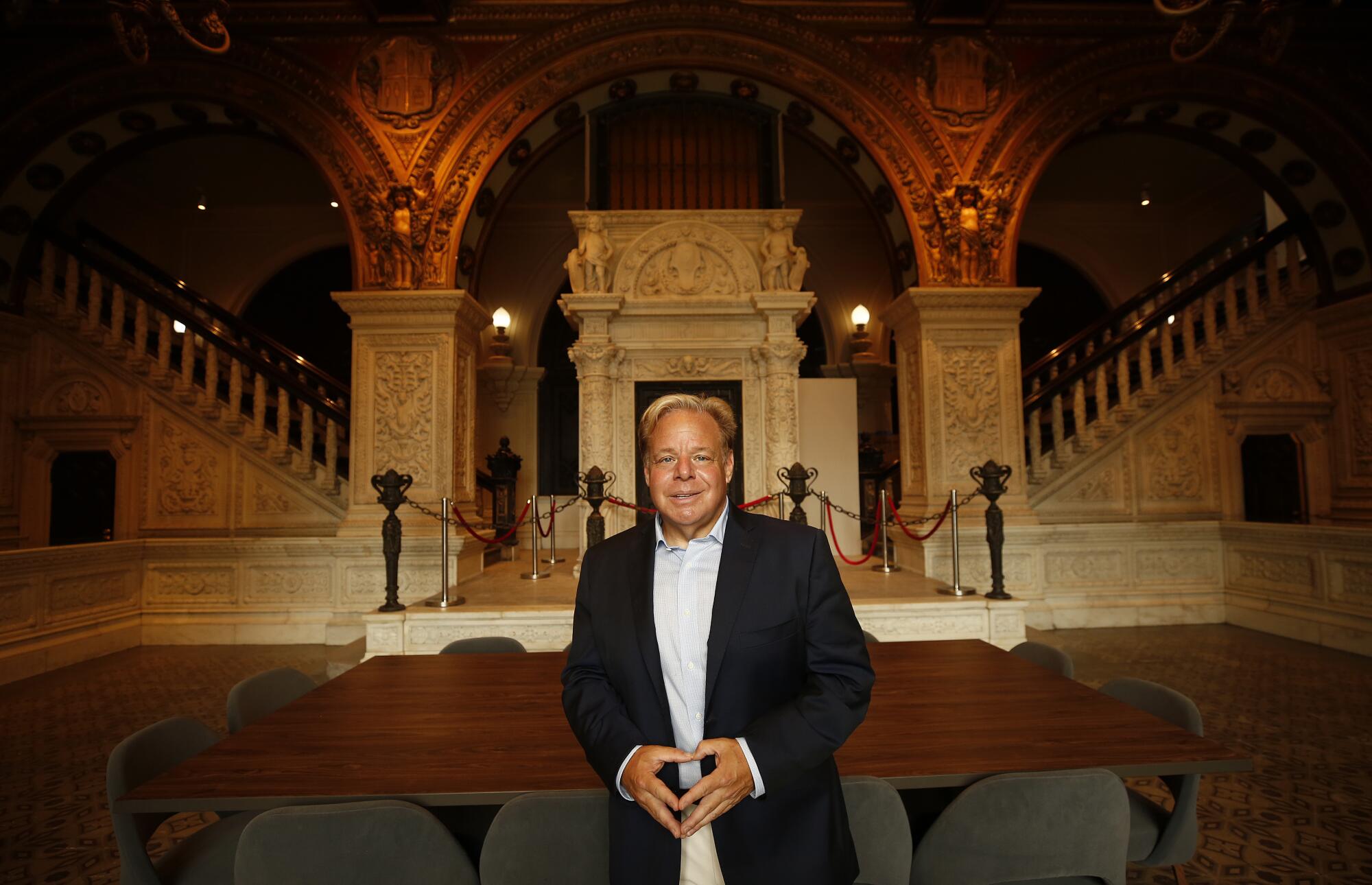
It has also been skewered by some critics for using mostly untenured faculty for its online programs and hyping achievements. Christopher Newfield, a UC Santa Barbara emeritus professor noted for his higher education research, has mixed views.
“It’s a two-sided picture: I like his focus on access and saying the quality of your institution should be measured by how many people you include and not exclude,” Newfield said. “On the other hand, ASU basically stresses platform alternatives to the tested face-to-face instruction that remains the gold standard in U.S. higher education.”
Enter the Los Angeles experiment, which aims to provide underserved students with both online instruction and twice-weekly in-person sessions at the ASU California Center at the HerEx building, developed by co-owner Georgetown Co., on 11th and Broadway. Maria Anguiano, a current UC regent who formerly worked at UC Riverside and the UC Office of the President, is running the initiative as an ASU executive vice president.
The nascent program has only enrolled 88 Los Angeles students as of fall 2021. Two-thirds of them are low-income, nearly three-fourths are Latino and Black students and 44% are the first in their families to attend college. And ASU sees plenty of opportunity to expand, calculating that 36,000 people between ages 18 and 25 who live within seven miles of the downtown center have graduated from high school but are not enrolled in local colleges.
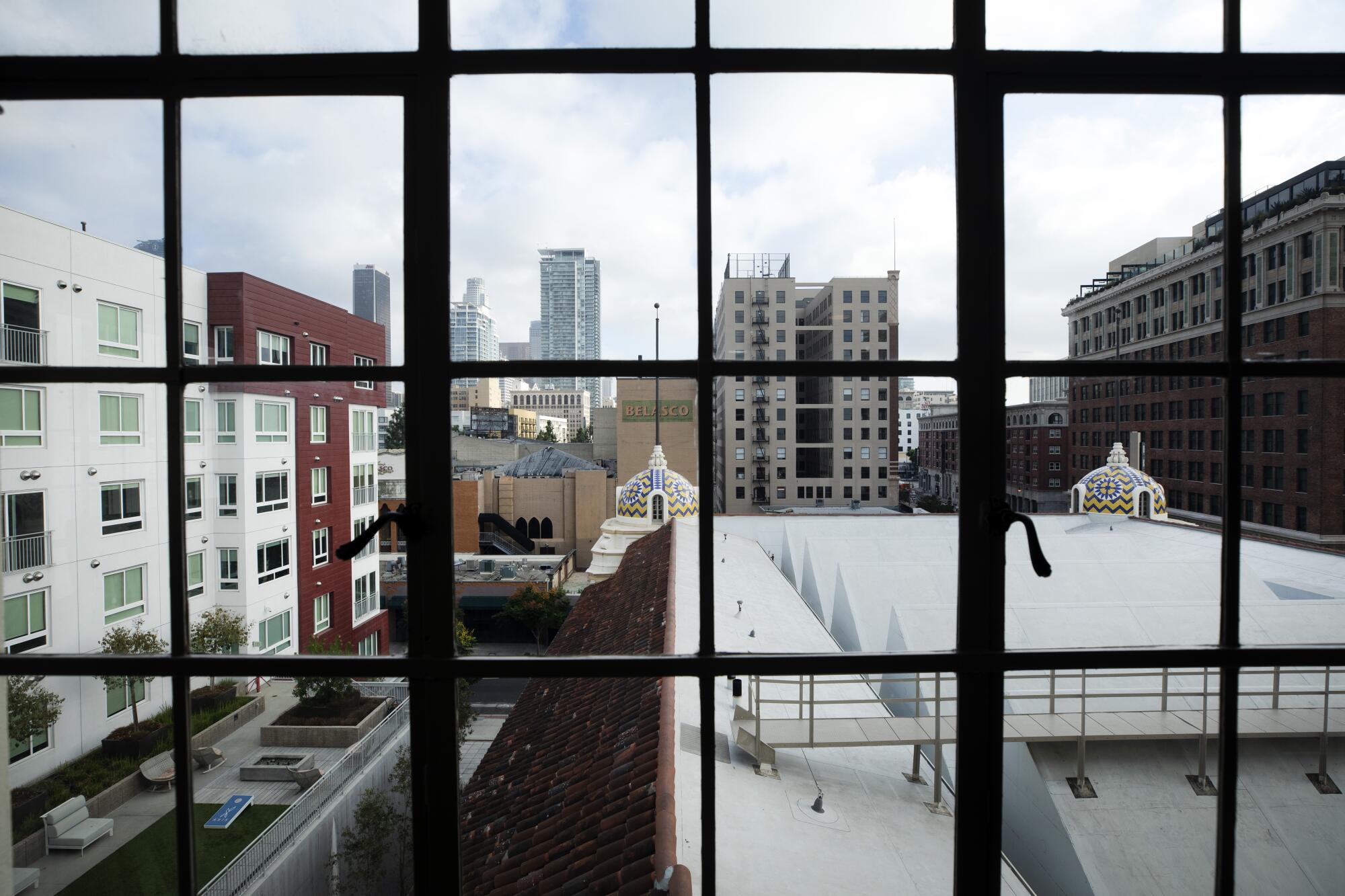
Each ASU Los Angeles student receives a scholarship to cover 20% of the annual nonresident online tuition of about $13,000 and may choose from more than 130 undergraduate degree programs. Cal State campuses offer far fewer, if any, online undergraduate degree programs — East Bay leads with two dozen — and individually set their own tuition; San Diego State, for instance, charges about $12,000.
“ASU made me feel like they actually care about you and I wasn’t just like one more number.”
— Kiana Tovar, Arizona State University student
It remains to be seen how successful the local program will be. ASU declined to provide academic outcomes for its Los Angeles students, saying it was too early to judge and that results would be skewed by the pandemic.
ASU’s educational technology, developed in part with several dozen California firms, includes adaptive and personalized learning tools that diagnose gaps in knowledge and skills and reteaches the material before advancing students to the next level. Crow credits such tools with helping increase four-year graduation rates to 54%, compared with 33% for Cal State. A new virtual reality biology curriculum, based on an “alien zoo” concept developed by Hollywood producers Steven Spielberg and Walter Parkes, was launched this year after a test run with 94 students showed grades improved three levels.
Students in Los Angeles say the technology helps — but that the personal relationships are what gets them through.

Julissa Rocha, a transfer student from Cerritos College, chose the ASU program because it offered an undergraduate forensic psychology program she couldn’t find at Cal State L.A., her closest campus. She started off well last fall, she said, but when a financial crisis hit her family, her math grade dropped to a D.
Her coach helped her apply for ASU emergency financial aid and a classmate tutored her in math, helping her raise her final grade to a B although she barely passed sociology with a D. The family difficulties have continued, but she has persisted and is managing a B in psychology and a C+ in criminology with a new major this semester.
“With online classes, you really feel like it’s all on you, but with the ASU Local program, they let you know ‘we have these resources for you and we’ll help you in any way we can,’” she said.
Tovar, who emigrated from Costa Rica in 2012 at age 17, took four years to get through El Camino College in part because she had to work to help support her household and figure out how to navigate the U.S. higher education system as the first in her family to attend college. She was admitted to Sacramento State but when she asked for financial aid information, she said she was given a counseling appointment a month away.
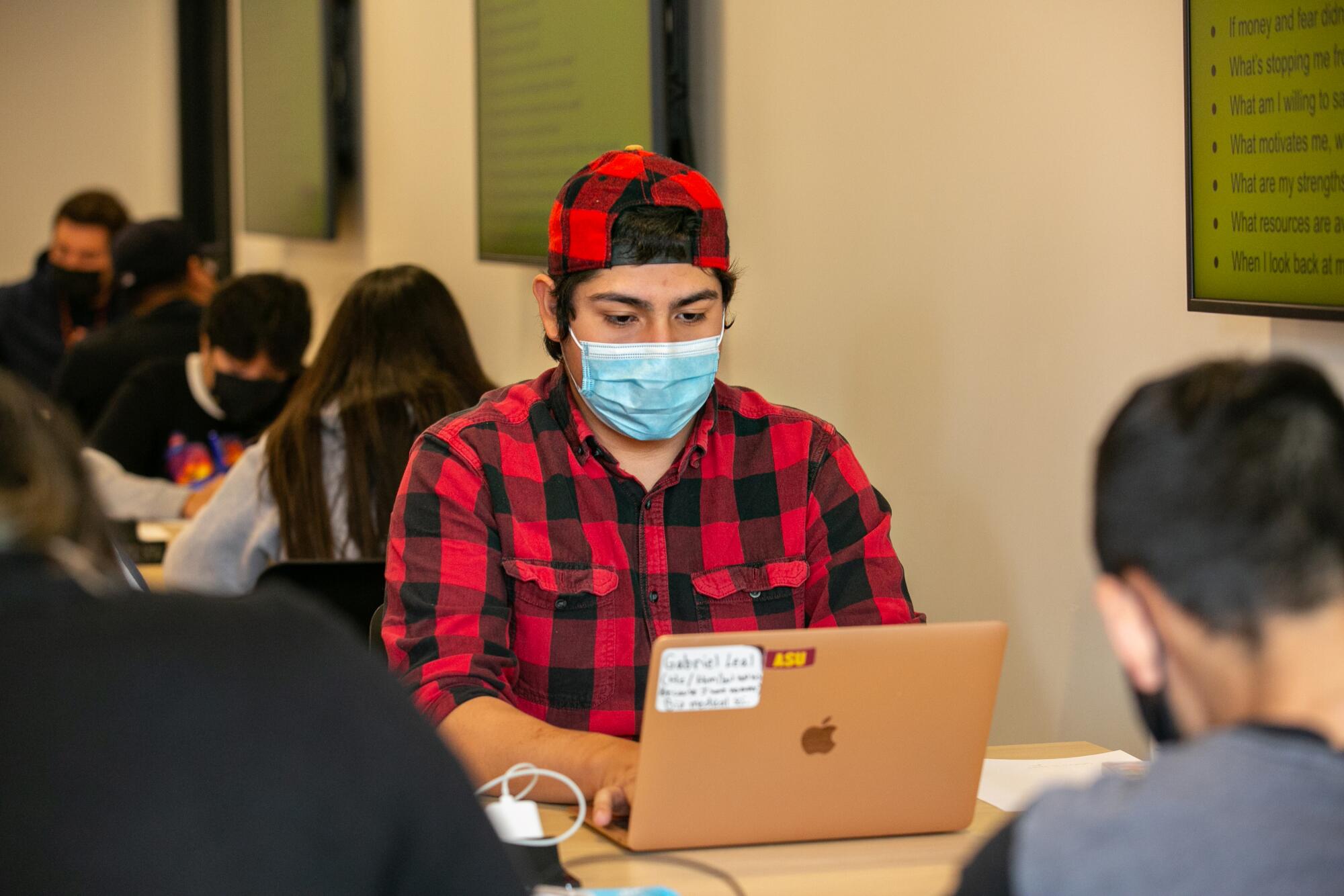
Then she saw an ASU ad on Instagram recruiting applicants for fall 2021 and emailed for more information. Within 30 minutes, she said, an ASU staff member responded. Phone calls quickly followed with a financial aid counselor, academic advisor, enrollment manager.
“ASU made me feel like they actually care about you and I wasn’t just like one more number,” Tovar said.
She, too, experienced unexpected difficulties during her first semester when mental health problems caused her to withdraw from classes. But she said that support from ASU staff motivated her to return this year; she is currently earning As in her two classes.
ASU’s experiment has caught the attention of California educational leaders. The Los Angeles-based ECMC Foundation, which promotes higher education for underserved students, gave ASU a $500,000 grant for the program. Peter Taylor, the foundation president and former Cal State trustee and UC chief financial officer, said ASU is meeting growing student desires for more scheduling flexibility and a greater connection between degrees and viable careers.
“This will be a nice opportunity for the CSU to see what works in the ASU model, build on it and — dare I say? — even copy it,” Taylor said.
Subscribers get early access to this story
We’re offering L.A. Times subscribers first access to our best journalism. Thank you for your support.
Crow, 66, a San Diego native, said his California dream isn’t driven by a need for more revenue, or lagging enrollment numbers in Arizona. Rather, he said, he views Arizona and California as key partners in a regional Southwest economy that his national research university should serve without regard to state boundaries. And those who want higher education should have it — whatever it takes.
“We’re driven by how do you make a public university work for the totality of the population,” Crow said. “If universities are a fixed model, they can’t really fulfill their mission. The system needs to be redesigned.”
More to Read
Sign up for Essential California
The most important California stories and recommendations in your inbox every morning.
You may occasionally receive promotional content from the Los Angeles Times.
